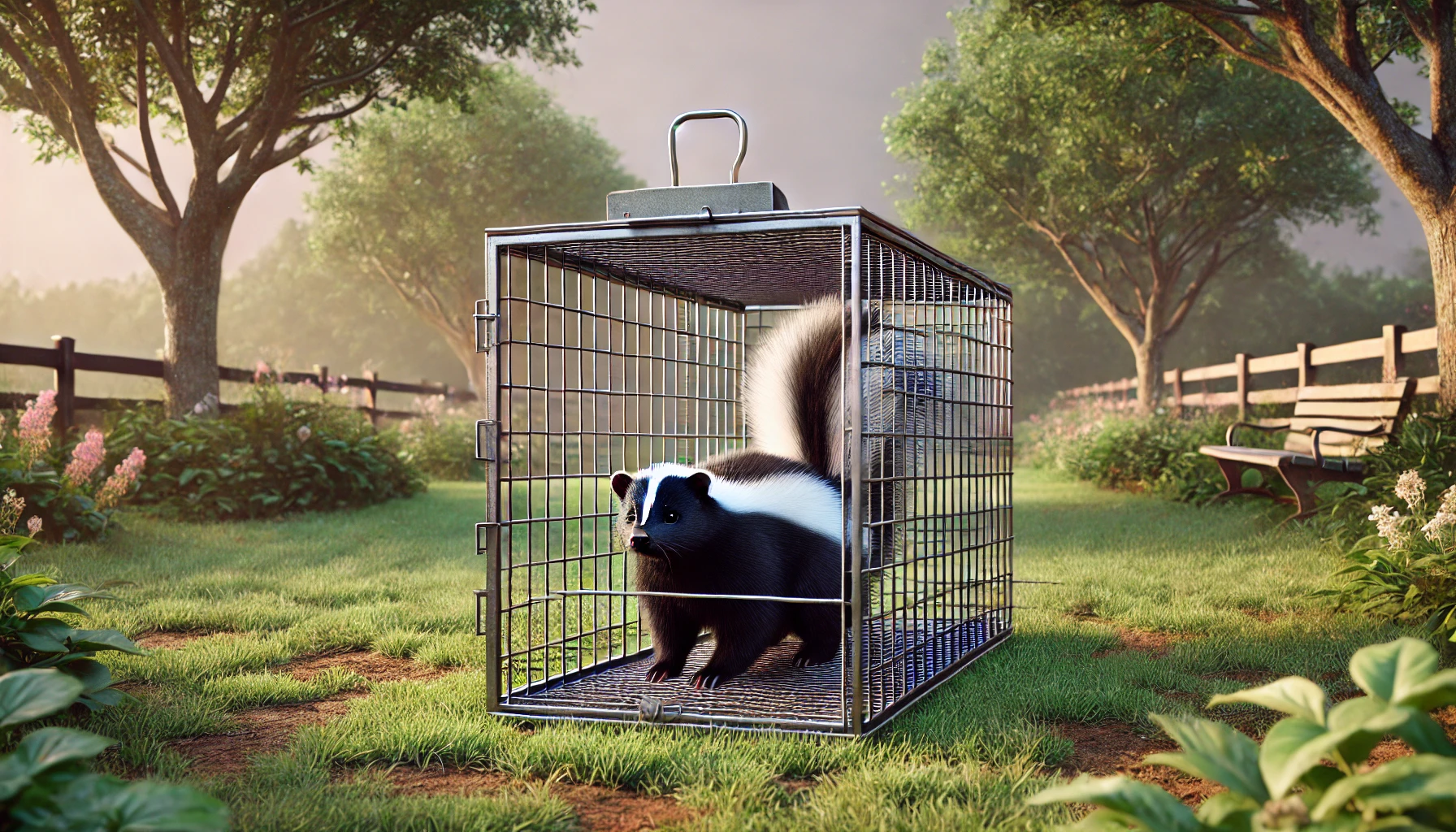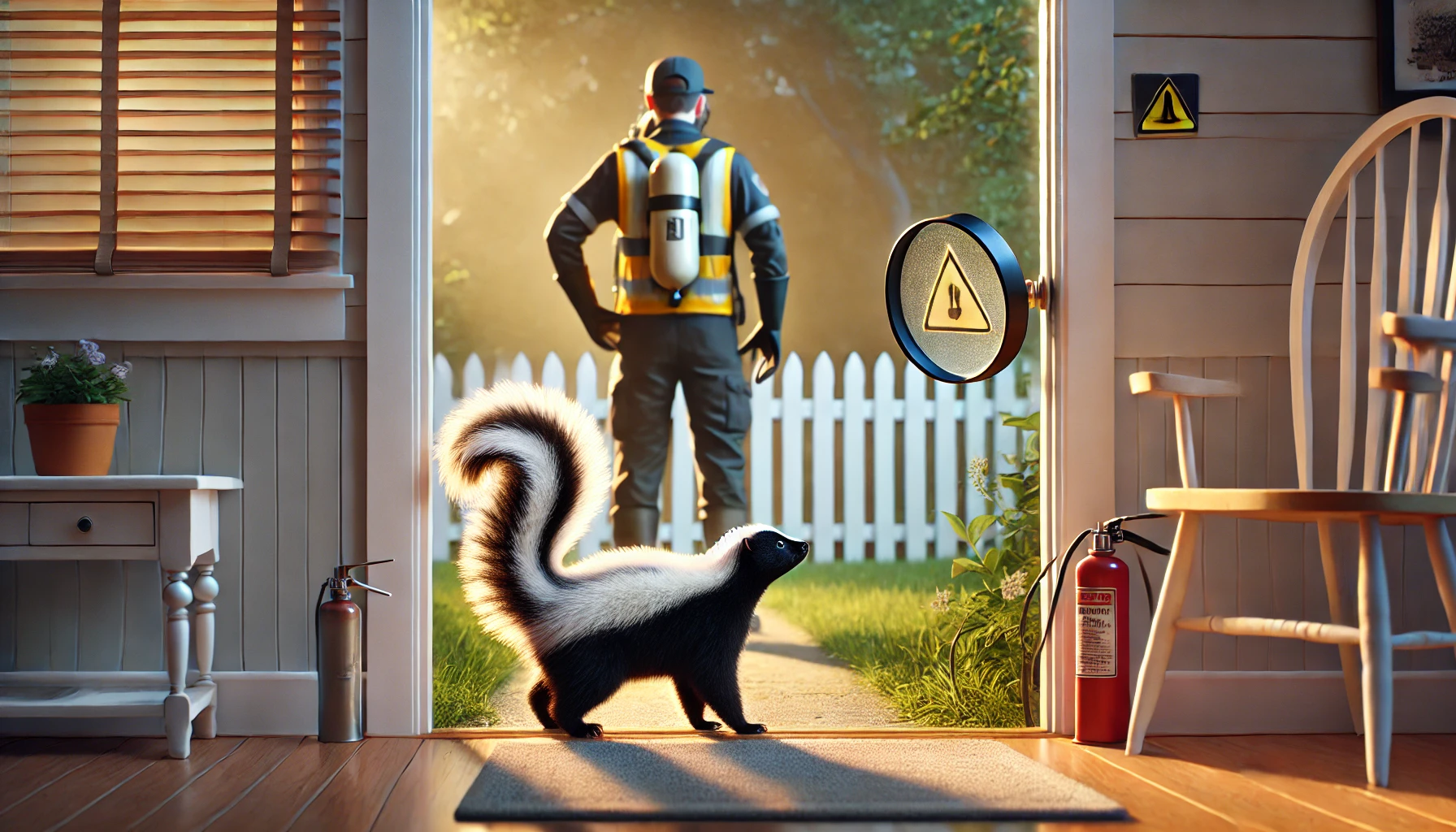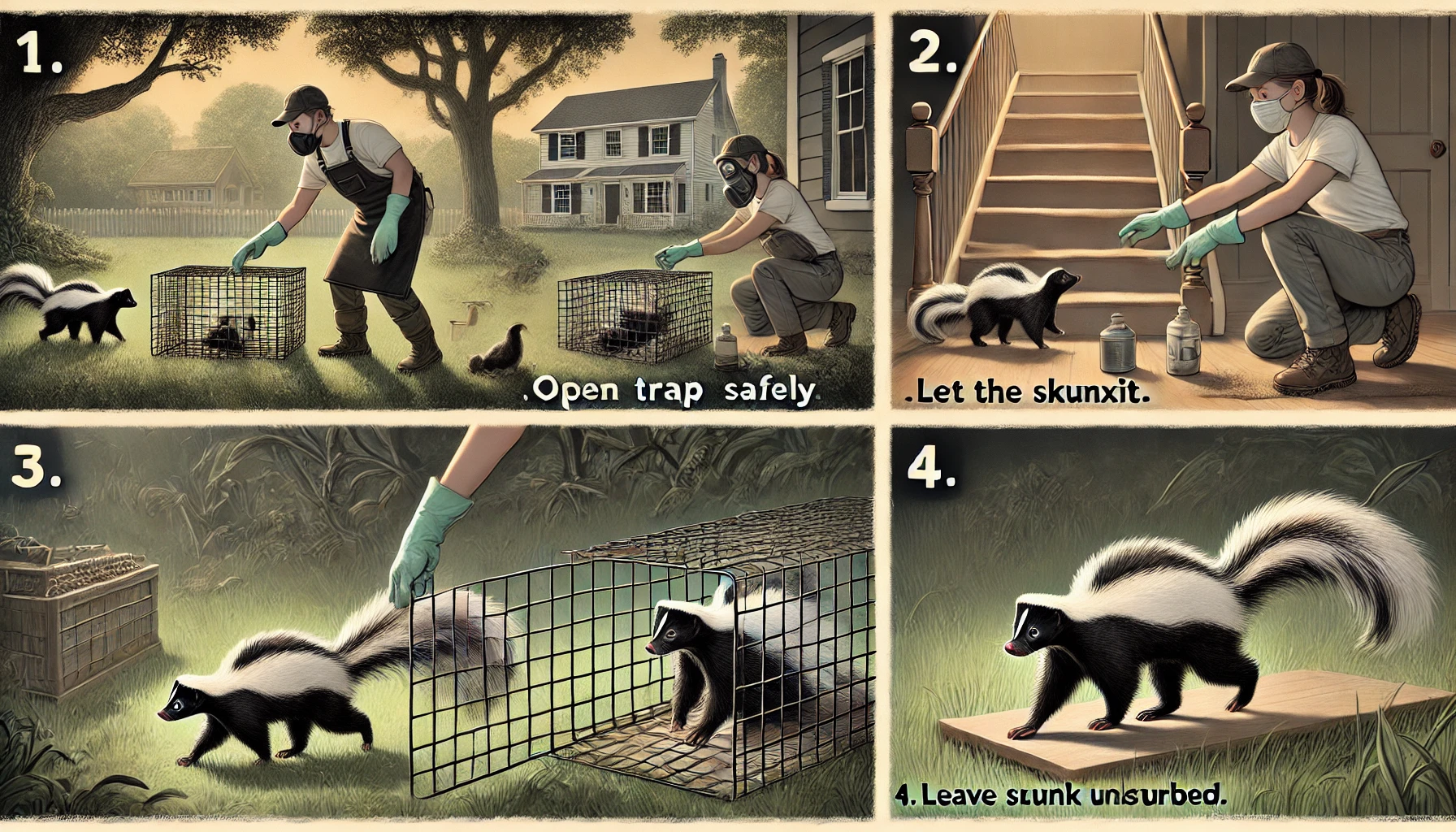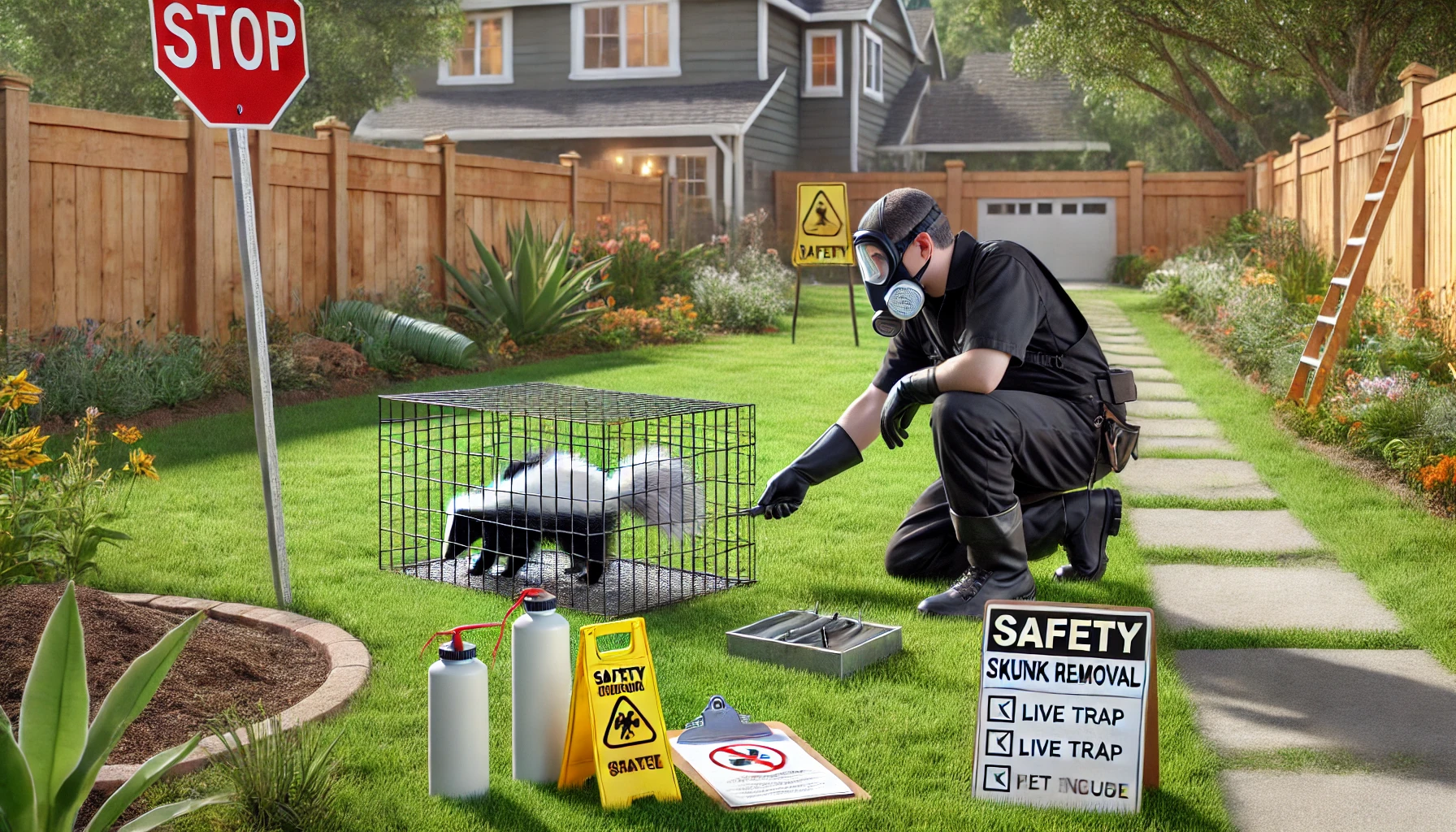Key Takeaways
-
Skunk Behavior: Skunks are generally non-aggressive but will spray when they feel threatened. Recognizing signs like a raised tail or stomping can help you avoid triggering their spray.
-
Essential Equipment: Protective clothing, a trap cover, and a safe transport method are essential for handling and releasing a skunk safely.
-
Stay Calm and Steady: Approach the skunk slowly and calmly to avoid stressing it. Sudden movements or loud noises can increase the risk of spraying.
-
Proper Release Location: Release the skunk at least a mile away from your home, ideally in a quiet, wooded area where it can find food and shelter away from predators and traffic.
-
Call a Professional if Needed: If you’re unsure or the skunk appears sick or injured, it’s best to contact wildlife control or animal rescue professionals for assistance.
 So, you have found a scank in a live trap. You are hearing the unconscious reshuffle of its small legs, and now you are thinking – what should I do now? Do not panic! Handling a scank, while difficult, if you know to take the right steps, it is not all complicated. With proper tools, patience and a cool attitude, you can safely leave the scank without spraying. And trust me, you do not want to be in the crossfire of that infamous smell.
In this guide, we will run you through all the things that you need to return that scank at that natural habitat without drama. Whether you’re dealing with an unexpected visitor or want to avoid further problems, we’ve got your back.
So, you have found a scank in a live trap. You are hearing the unconscious reshuffle of its small legs, and now you are thinking – what should I do now? Do not panic! Handling a scank, while difficult, if you know to take the right steps, it is not all complicated. With proper tools, patience and a cool attitude, you can safely leave the scank without spraying. And trust me, you do not want to be in the crossfire of that infamous smell.
In this guide, we will run you through all the things that you need to return that scank at that natural habitat without drama. Whether you’re dealing with an unexpected visitor or want to avoid further problems, we’ve got your back.


Not getting a solution?
Get your free pest control estimate today!Why Should You Be Careful with Skunks?
Skunks are pretty low-maintenance when it comes to behavior. They don’t want trouble. But if they’re cornered or stressed, they will use their spray as a defense mechanism. That spray is no joke—it can shoot up to 10 feet, and the smell will haunt you for days. So, while skunks are generally calm creatures, understanding their behavior is key to keeping everyone (including you) safe.Red Flags: Signs the Skunk Is About to Go Full Spray
-
Raised Tail: A clear warning that the skunk feels threatened and is preparing to defend itself.
-
Stomping: The classic “back off” move. If you see this, a spray is likely coming soon.
-
Hissing: The final warning before the spray—if you hear this, retreat quickly to avoid getting sprayed.

Step 1: Get Your Gear Ready
- Alright, you’re ready to tackle the situation. But before you do anything, make sure you’ve got your protective gear on hand. You don’t want to find yourself too close to that spray. Here’s what you’ll need:
-
Protective Clothing: Wear long sleeves, pants, gloves, and eye protection to stay safe from the skunk’s spray.
-
Trap Cover: Use a thick, dark cloth or tarp to cover the trap. This not only calms the skunk but also prevents accidental triggering of its defenses.
-
Transporting Gear: If the release site is far, use sturdy rope or straps to secure the trap in your car. Avoid shaking it to keep the skunk calm.
-
Release Location: Pick a remote, safe area for release, away from homes or busy roads, where the skunk can safely wander off.
Step 2: Calm, Steady Approach
- You know what they say—slow and steady wins the race, and that’s true here. Skunks are skittish, and any sudden movements can set them off. So, here’s the deal:
-
Take It Slow: Approach the trap calmly, avoiding quick steps and loud noises. Skunks are sensitive to movement and sound, so give them time to adjust.
-
Take a Moment: Check if the skunk appears unwell or stressed. If you’re unsure about its health, don’t hesitate to call animal control for professional assistance.
Step 3: Cover the Trap
- Okay, here’s the game-changer: covering the trap. Skunks are prey animals, so they’ll feel much more at ease when they can’t see potential threats. Here’s how you do it:
-
Use a Tarp or Cloth: Take a thick, dark-colored cloth or tarp and gently drape it over the trap. This gives the skunk privacy and helps calm it down.
-
Go Slow: Move the cloth slowly to avoid startling the skunk. Quick motions can cause unnecessary stress, so take your time to ensure the skunk feels secure.
Step 4: Transport the Skunk (If Necessary)
- If the release site is too far for walking, you’ll need to move the trap. Don’t worry; we’re keeping things easy:
-
Secure the Trap: Once the trap is covered, secure it in your car using sturdy rope or straps to keep it from moving around during transport.
-
Drive Smoothly: Drive gently, avoiding sharp turns or sudden stops to keep the skunk calm and prevent it from getting stressed and spraying.
Step 5: Find the Right Place to Let It Go
- Finding the perfect spot is the secret sauce. Skunks are pretty smart and have a good sense of direction. Here’s what to keep in mind:
-
Far Enough from Home: Release the skunk at least a mile from your home to prevent it from finding its way back to familiar territory.
-
Away from Busy Roads: Skunks should be released in a remote, quiet area away from traffic—woods or fields are ideal locations.
-
A Natural Habitat: Wooded areas with food sources offer the skunk a safe place to find shelter and avoid predators.
Step 6: Let the Skunk Go
- Here’s the part we’ve all been waiting for—the release! Let’s make sure this part goes smoothly:
-
Set the Trap Upright: Position the trap so that the door faces the open area, providing a clear path for the skunk to exit.
-
Open the Door Slowly: Gently open the trap door and step back. Allow the skunk to leave on its own without feeling rushed.
-
Stay Calm: Stand back and avoid making loud noises or sudden movements. Give the skunk enough space to feel safe and exit at its own pace.

When to Call a Professional
Okay, here is the point – if you are feeling uncomfortable about the whole process or the skunk looks injured, sick, or highly stressed, do not hesitate to call a professional . Animal control or a local wildlife rescue team can safely handle the situation, and they know how to deal with any possible issues.If you feel things have gone out of control, it is advised to contact pest control professionals. Our team can provide a customized approach to protect your home effectively.
Visit our Species, Control, and DIY Guide sections for additional resources on skunk and ways to tackle a skunk infestation.





